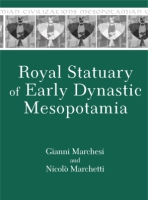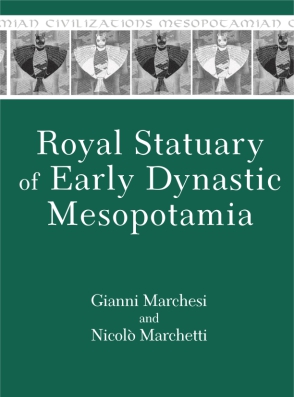Royal Statuary of Early Dynastic Mesopotamia
Gianni Marchesi and Nicolò Marchetti
“This book is an important, engaging and multifaceted account that is sure to provoke discussion and debate. It deserves to become a classic interpretation of the archaeology and royal iconography of third millennium BC Mesopotamia and should be the first port of call for anybody interested in a detailed understanding of the period. Marchesi and Marchetti deserve our congratulations and thanks.”
- Description
- Reviews
- Table of Contents
Starting from these observations, the authors proceed to investigate the ideology of early polities in Mesopotamia and the role and functions of the king. Along with a new chronology of Early Dynastic rulers and an outline of Early Dynastic history, discussions of significant monuments and inscriptions are offered. In addition, all known inscriptions on royal statues are edited and provided with detailed commentaries.
First published in 2006 as La statuaria regale nella Mesopotamica Protodinastica (Rome: Bardi Editore).
“This book is an important, engaging and multifaceted account that is sure to provoke discussion and debate. It deserves to become a classic interpretation of the archaeology and royal iconography of third millennium BC Mesopotamia and should be the first port of call for anybody interested in a detailed understanding of the period. Marchesi and Marchetti deserve our congratulations and thanks.”
“Royal Statuary of Early Dynastic Mesopotamia will pay dividends to any reader who invests in its wide-ranging and multidisciplinary view of early Mesopotamian royal visual culture. The collaboration between the authors is an encouraging sign of the future of research in the field of ancient visual culture.”
Preface
Introduction
Chapter 1. Archaeological Contexts and Chronology of Early Dynastic Statuary
1.1. The Main Contexts of Stratified Early Dynastic Statues and Other Visual Material
1.1.1. Tell Asmar (Ešnunak), Khafajah (Tutub), and Tell Agrab (PA.GAR)
1.1.2. Nuffar (Nippur)
1.1.3. Tello (Girsu)
1.1.4. Bismaya (Adab)
1.1.5. Tell al-Muqayyar (Ur)
1.1.6. Tell al-ʿUbaid (Nūtur)
1.1.7. Tell Hariri (Mari)
1.1.8. Qalºat Shergat (Aššur)
1.1.9. Tell Ingharra (Kiš)
1.1.10. Shush (Susa)
1.1.11. Some Groups of Sculpted Artifacts from Other Mesopotamian Sites
1.2. Early Dynastic Chronology and the Development of Visual and Epigraphic Artifacts
Chapter 2. Historical Framework
2.1. Political Development in Early Dynastic Mesopotamia: An Outline
2.2. Royal Titles and Ideology of Kingship
2.3. The Sumerian King List
2.4. Early Dynastic Rulers
Chapter 3. Early Dynastic Royal Statuary
3.1. Royal Statues Identified on Epigraphic Grounds
3.2. Uninscribed Statues Presumably Commissioned by Rulers
3.3. The Development and Meaning of Royal Statuary
3.4. Catalogue of Early Dynastic Royal Statuary
Chapter 4. The Inscriptions on Royal Statues
4.1. Preliminary Observations
4.2. Definition of the Corpus
4.3. Statue Inscriptions (Cat. 1–12)
Chapter 5. Kingship and Visual Communication in the Early Dynastic Period
5.1. The Protohistoric Era and the Problem of Identifying the “Priest-King”
5.2. The Iconography and Themes of Early Dynastic Art
5.3. Ebla and Early Syrian Culture
Chapter 6. Conclusions
6.1 Iconographic Details and Visual Significance: The Ruler and the Early State Administration
6.2. From Participation to Individualism: The Development of Royal Visual Propaganda in Early Dynastic IIIa–b
Appendix A. Remarks on Early Dynastic Temples
A.1. Characteristics of Early Dynastic Sanctuaries
A.2. Temple Names and Titular Deities
Appendix B. Royal Statues in Administrative Texts
Appendix C. Notes on the Transliteration of Texts and the Transcription of Proper Names
I. Personal Names
II. Divine Names
III. Geographical and Topographical Names
Abbreviations
Bibliography
Philological Index
Sources of Illustrations
Plates
Also of Interest
Mailing List
Subscribe to our mailing list and be notified about new titles, journals and catalogs.





